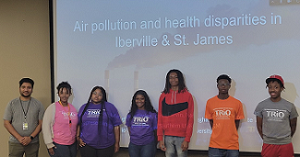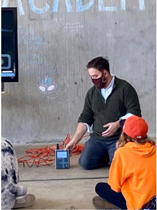Features
Documenting Differences in Exposures and Health to Advance Health for All
A critical component of all SRP-funded research centers is the community engagement core, which works directly with affected communities to address their environmental health concerns. Many of these communities are disproportionately exposed to hazardous substances or bear greater health burdens due to social, economic, or demographic factors. This feature highlights a subset of those centers that document disparities in exposure and health based on such factors, while working towards practical solutions.
To learn more about how SRP grant recipients are addressing the disproportionate exposure to hazardous chemicals of Native American communities across the U.S., read the September 2023 Science Digest. You can also read more about how SRP-funded teams are working to get science into the hands of people who can use it through highly tailored communication resources, tools, and collaborations in the September 2021 Science Digest.
Protecting Maternal and Children's Health
The Northeastern University Puerto Rico Testsite for Exploring Contamination Threats (PROTECT) SRP Center focuses on understanding how exposure to hazardous substances contributes to high rates of adverse pregnancy outcomes, such as preterm birth, in Puerto Rico. The PROTECT team has revealed associations between lower socioeconomic status and markers of oxidative stress in pregnancy and significant interactions between exposure to metals, such as manganese, copper, or nickel, and preterm birth in women with higher perceived stress, depression, and lower social support. They also used a data mining approach to reveal how exposure to an array of chemicals contributes to racial disparities in preterm birth.

PROTECT employs innovative approaches to engage and educate the community, involve study participants in research, report back data, and communicate with stakeholders. The team's innovation was to create MiPROTECT, a smartphone app that provides study results in a culturally appropriate and easy-to-understand way to participants. This approach also increases trust in the research and aids development of environmental health literacy.
Tools Aim to Promote Clean Water for All

SRP-funded researchers help identify factors that may make some populations more likely to be exposed to higher levels of drinking water contaminants. For example, researchers at the University of Rhode Island SRP Center found that community water systems serving primarily Hispanic, Latino, and non-Hispanic Black residents were more likely to have PFAS contamination. Similarly, the Columbia University SRP Center team reported higher levels of arsenic and uranium in public drinking water in areas with higher proportions of Hispanic, Native American, and non-Hispanic Black residents.
The University of California (UC) Berkeley SRP Center team has reported links between socioeconomic status and arsenic-related diabetes risk. They also found a link between drinking water contaminants and blood pressure disorders in pregnancy based on neighborhood poverty, socioeconomic status, and race. To help inform communities about their water quality, they collaborated with the Community Water Center to develop the Drinking Water Tool, an interactive and easily accessed web portal.

Researchers at the University of North Carolina at Chapel Hill (UNC) SRP Center study disparities in toxic metals exposure among residents who rely on private wells for drinking water. The researchers developed NC Enviroscan, a tool that helps communities visualize environmental and social factors in their area that affect health.
UNC SRP Center researchers also created two approaches to advancing environmental health equity among affected communities in North Carolina:
- The Chemical and Social Stressors Integration Technique provides a framework to identify distinct geographic areas at risk based on environmental chemical exposure, social vulnerability, and access to resources.
- The Toxic Metal Environmental Justice Indices approach compares the percentage of a region’s population with low income and minority status, with water samples exceeding national standards for arsenic, cadmium, lead, or manganese, to prioritize areas for intervention or remediation.
Addressing Community Concerns About Air Pollution

Researchers from the Louisiana State University SRP Center work with residents of Colfax, Louisiana, to study environmental exposure and health impacts from a nearby hazardous waste thermal treatment facility. Colfax is home to mainly Black residents, most of whom live below the poverty line.
The team has collected oral histories to document the community's experience. They also used community-integrated GIS studies to validate their experiences of health symptoms with known waste treatment emissions and toxicological information about the compounds involved. According to the team, oral histories are a useful tool to understand community perceptions and to improve participation in decision making.
At the University of Louisville SRP Center, researchers are working to understand how communities in rural Kentucky are disproportionately exposed to and affected by volatile organic compounds (VOCs) based on social and economic factors. For example, they have identified complex associations between exposure to VOCs and liver injury based on biological sex and race.
Louisville SRP Center scientists also explore how green spaces — areas with trees and other vegetation - can reduce air pollution exposure, improve mental health and overall well-being, and lower disease risk. According to the team, initiatives that promote green spaces may be a useful strategy to improve health equity.
Addressing Disparities in Rural and Urban Communities

Researchers at the University of Kentucky SRP Center are responding to community concerns about exposure to harmful contaminants in rural Kentucky, identifying nutritional interventions, such as eating blackberries, as a simple and cost-effective way to improve health. They educate communities about how diet and lifestyle changes can help protect against the harmful effects of environmental toxins. They also build community-academic partnerships to increase blackberry gardening and consumption at senior centers.
At the Wayne State SRP Center, researchers study how VOCs contribute to high preterm birth rates in Detroit, a large city with a legacy of toxic waste and nearly 40% of its population living below the poverty line. Researchers have reported associations between socioeconomic conditions and race with higher proportions of open brownfield sites, land previously used for industrial or other commercial purposes, in neighborhoods.
Protecting Communities During Disasters

The Texas A&M University (TAMU) SRP Center works to understand how climate-related and other disasters increase health risks associated with contamination events, particularly for communities disproportionately affected.
They have documented how historical discriminatory policies, such as redlining, contribute to disparities in heat-related illnesses, pointing to the need for equity-based urban planning and management. They work closely with communities affected by environmental disasters to develop interventions to reduce exposure to harmful substances during emergencies, while identifying opportunities to proactively plan for and manage future exposure risks. Examples include:
- HGBEnviroScreen, which integrates information on health, environmental exposures, social vulnerability, and flooding to identify and prioritize at-risk regions for environment plans.
- Climate Vulnerability Index Dashboard, which captures long-term health, social, environmental, and economic conditions that shape a community's ability to withstand hotter heat waves, drier droughts, and other increasing climate threats.
to Top



